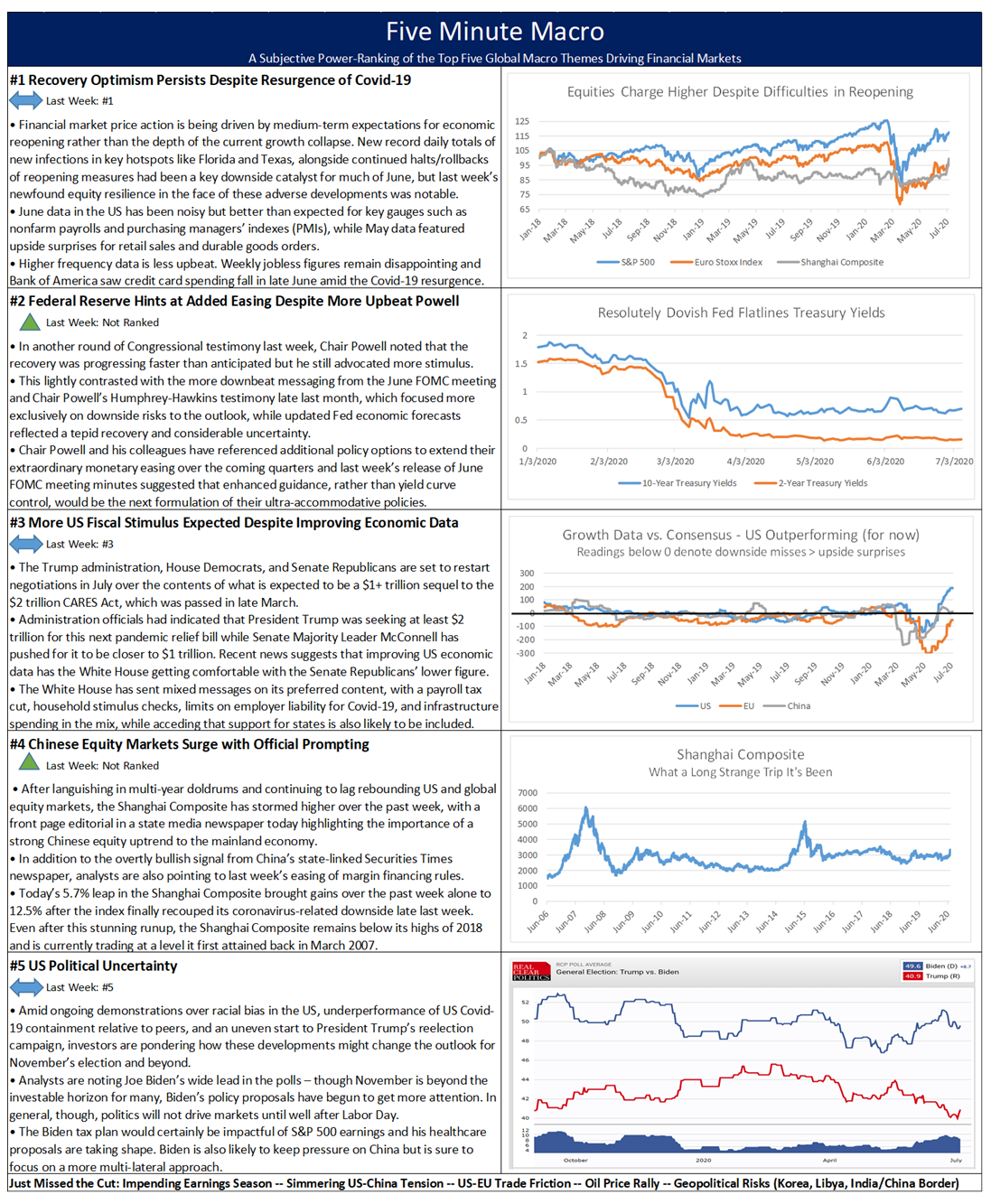Summary and Price Action Rundown
Global risk assets are were mixed overnight as investors brace for a highly uncertain second quarter corporate earnings reporting season while monitoring escalating US-China tensions and ongoing efforts to counter the Covid-19 resurgence. S&P 500 futures point to a 0.4% gain at the open after the index registered a new high for the pandemic period yesterday, briefly surmounting the early June peak before retreating to close 0.9% lower. The tech-heavy Nasdaq also fell from its latest record high. Equities in the EU are retracing yesterday’s gains, while Asian stocks moved lower overnight as US-China relations deteriorated further (more below). The dollar is flat and longer-dated Treasury yields are holding above recent lows, with the 10-year yield at 0.63%. Brent crude prices remain below $43 ahead of tomorrow’s OPEC meeting.
Uncertain Earnings Season Gets Underway
Leading US megabanks begin issuing second quarter (Q2) results this morning as analysts brace for surprises amid a lack of guidance. This morning, Citigroup, JPMorgan, and Wells Fargo are reporting before the opening bell in the unofficial start to Q2 earnings season. In particular, investors will scrutinize details on credit quality as the difficulties being encountered in reopening the economy have raised questions as to the banks’ preparedness for an extended recession, even though they have a solid cushion of cash for loan-loss protection and have recently passed Fed stress tests. For context, in Q1 banks added a tremendous amount of cushioning to their loan-loss reserves, with JPMorgan posting nearly $7 billion to take its reserves to $8.2 billion in the first quarter, while Bank of America and Citigroup added nearly $4 billion, and Wells Fargo topped-up by around $3.5 billion. On the more positive side, analysts note that rising fee revenue from accelerating investment-banking activity and increased mortgage lending fees during the quarter should both help offset banks’ rising credit costs. Surveys indicate that JPMorgan, Goldman Sachs, and Morgan Stanley are expected to have earnings-per-share (EPS) growth from Q1, while EPS consensus estimates for Bank of America, Citigroup, and Wells Fargo suggest downside risk. Meanwhile, management commentary will be very important for adding color to the macro picture. For Q2 earnings season overall, with expectations having been so deeply downgraded, it is generally anticipated that a significant percentage of reporting companies will beat consensus projections, but there will likely be a large sectoral divergence in performance.
US-China Tensions Remain in Focus
Rhetoric remains heated as the US and China trade policy and strategic jabs, but both sides are showing restraint and the friction has yet to ignite a major escalation. With US and Chinese officials trading tit-for-tat sanctions over the repression of Uighur Muslims in the Xinjiang province in recent days, the atmosphere of relations between Washington and Beijing continued to deteriorate over the past day as the US rejected China’s territorial claims in the South China Sea, characterizing them as “unlawful” and China’s posture in the region as “bullying.” Analysts noted that this was a departure for the US, which had previously not taken a clear position on such issues, instead advocating generally for freedom of navigation in the South China Sea. In retaliation, Chinese officials decried the US stance over regional security and announced sanctions on Lockheed Martin relating to arms sales to Taiwan. Shares of the defense industry giant are only 1.1% lower in pre-market trading.
Additional Themes
Decent EU Economic Data Contrasts with Dismal UK Figures – The euro is moderately higher versus the dollar this morning after EU industrial production figures and a closely-followed German business confidence survey both slightly missed estimates but remained consistent with a rebound. EU industrial production for May expanded 12.4% month-on-month (m/m), falling short of the 15.0% forecast but evidencing swift improvement from Aprils’ dire -18.2% m/m reading. The year-on-year (y/y) pace remained deeply negative at -20.9% but this marks a gain from the -28.7% y/y contraction for the prior month. Meanwhile, Germany’s ZEW business expectations index for July settled at 59.3 versus an estimate of 60.0 and 63.4 in June. Meanwhile, the pound is weaker versus the dollar as UK May GDP missed expectations by a wide margin, showing a 1.8% m/m expansion, undershooting the 5.5% forecast with weakness evident in services and construction.
Cheering Up Down Under – Australian business optimism returned to positive territory for June. National Australia Bank’s (NAB) index of business confidence picked up to 1 from -20 in May as the country began to emerge from coronavirus lockdowns. Still, the latest reading remains below the long-run average of 6. Mining and retail led the gains, with services still lagging due to social distancing and a lack of tourists. Business conditions bounced back but remained negative (-7 versus -24 in May). “The survey was conducted just prior to the reintroduction of lockdowns in Victoria – so we will be closely watching next month’s survey to see how confidence and conditions are again impacted,” said NAB chief economist Alan Oster. The Australian dollar is up 0.2% versus its US counterpart and hovering near one-year highs.

